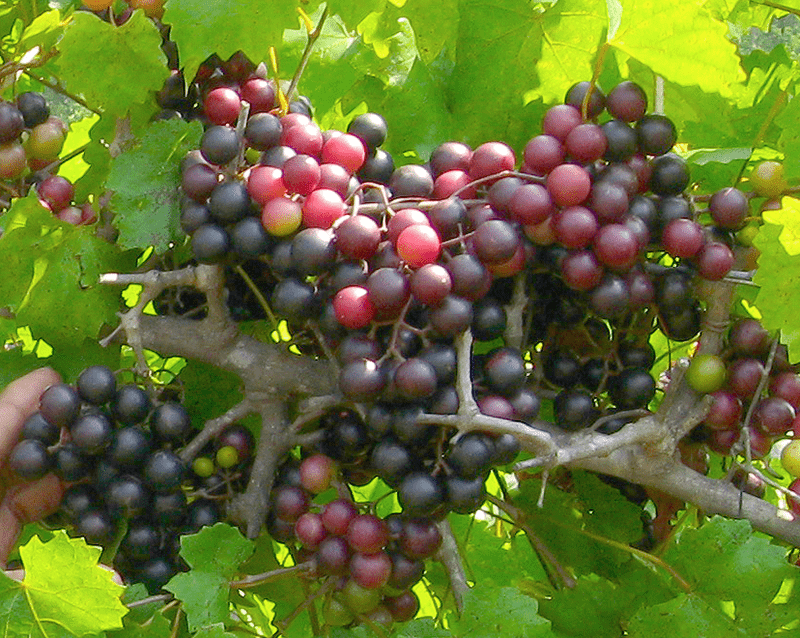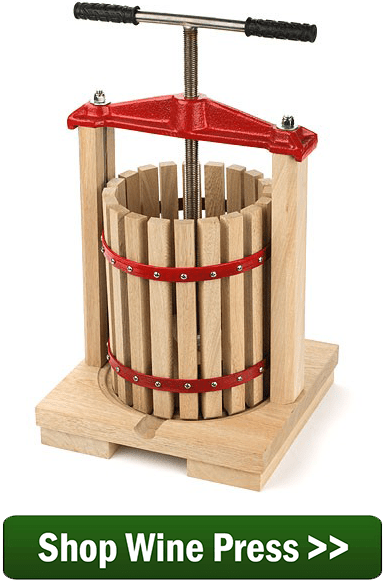 My question is related to making both Muscadine and Scuppernong with 100% pure juice. I have an opportunity to obtain 100% pure juice for both products with a Brix range between 22.0-23.0.
My question is related to making both Muscadine and Scuppernong with 100% pure juice. I have an opportunity to obtain 100% pure juice for both products with a Brix range between 22.0-23.0.
I have always utilized real, whole fruit in all my batches and I am not sure if there are recipe differences when using pure juice. Do you have a Muscadine recipe or a Scuppernong recipes that I could follow utilizing 100% grape juice? Are all the wine making ingredients the same? Do I add water or more sugar considering the Brix is in the ideal range?
I really appreciate your assistance.
Best Regards,
John and Cathy H.
—–
Hello John and Cathy,
Most fresh Muscadine or Scuppernong wine recipes you will find typically call for both water and sugar in addition to the juice/grapes:
- Water: to lower the higher acidity typically found in these grapes. If you use straight Scuppernong or Muscadine juice, you will most likely end up with a wine that is too tart.
- Sugar: to bring the potential alcohol of the wine back up to a decent range. Because you added water to dilute/lower the acidity of the juice, you will need to add sugar to bring the potential alcohol level up to a descent range: 10% to 13%.
However, these wine recipes can only guess as to what are the optimal amounts of each. My suggestion to you would be to purchase two items to help you bring everything into optimal balance:
- Acid Testing Kit: This kit will allow you to test the acidity level of the Scuppernong or Muscadine juice. The acidity relates to the sourness/sharpness of the wine verses the flatness/lifelessness of the flavor. The acid testing kit also comes with directions that will tell you what the optimal readings are, so you can calculate how much water to add to the juice, if any. I would shoot for an acid reading of around .65%.
- Wine Hydrometer: This priceless instrument is what tells you what the brix reading is of the juice. Your supplier has already given you a brix range of 22 to 23, but these numbers will change if you have to dilute the grape juice with water to lower the acidity. The wine hydrometer will tell you what the new brix reading is and help guide you back to a brix range of 22-33 when adding sugar back to the wine must.
As for the rest of the wine making ingredients, you can follow the wine recipes on the wine recipes page of our website. There you will find a Muscadine wine recipe and a Scuppernong wine recipe. Basically, add the following for every 5 gallons of wine must:
- 5 Tsps. Yeast Nutrient
- 3/4 Tsp. Pectic Enzyme
- 1 Tsp. Tannin
 The wine yeast recommended for the Scuppernong is the Lalvin type: K1V-1116; for the Muscadine the Red Star type: Pasture Blanc is recommended.
The wine yeast recommended for the Scuppernong is the Lalvin type: K1V-1116; for the Muscadine the Red Star type: Pasture Blanc is recommended.
What About Fresh Muscadine And Scuppernong Grapes?
I would also like to point out that the above information can be applied to making wine from actual Muscadine a Scuppernong grapes. Just crush the grapes then take a reading with your gravity hydrometer and acid test kit, and take it from there.
Happy Wine Making,
Ed Kraus
—–
Ed Kraus is a 3rd generation home brewer/winemaker and has been an owner of E. C. Kraus since 1999. He has been helping individuals make better wine and beer for over 25 years.

I live in GA, plenty of those grapes. I think I will make a batch.
I want to thank you !!
Where can you buy cans of Muscadine and Scuppernog juice to make wine with. That is my favorite kind of wine.
Janet, unfortunately, we do not have any information as to where you can purchase Muscadine or Scuppernog juice.
I have seen and bought muscadine juice at Ingles grocery store, I live in Forsyth, Ga. I know it is sold there.
I recently made 5 gallons of Scuppernong with juice only getting it from my wine press (2/12 gal. juice, 4 gal.water and 9 pounds sugar. It was super! It was the closes to store bought white wine in taste I’ve ever made. It was crystal clear like water.
I have about 24 quart jars each of muscadine and scuppernog juice that I home-canned last fall. I also have frozen grapes of both varieties from my fall 2019 harvest and should have plenty of fresh grapes from my vines in a couple of months. If you are near southeast NC, let me know if you want to purchase any. I am not a commercial grower or wine maker. I make (delicious)small-batch wines for my own use using EC Krauss information..
Hi Sharon,
I just ran across this blog. I live in Raleigh, NC., and plan to make muscadine wine this fall. I see that you are selling the grapes. How much are you asking for them, and how far are you from the Raleigh area ?
Thank you for your reply
Mike
I have muscadine vines (red and white) and have tried to make wine but they always taste so sour/tart that I can’t drink it. My ph kit gets a reading of 3.2 and after wine sits in bottle for several months it turns brown. I am at the point of giving up. I have purchased Ascorbic acid in hopes it will help maintain color.Will the Vintners Harvest yeast give me a better taste?
Sarah, the sour/tart taste is because the acid is too high. You are looking for a reading between 3.4-3.8. The pH scale works backwards so the lower the number the higher the acid. Below we have posted an article that that discusses getting the acid in range. When a wine turns brown/orange it is because the wine is oxidizing. This happens when the wine comes in contact with too much air like having to much headspace in the fermenter. For information on how to prevent this, please see the article posted below.
Getting A Handle On Wine Acidity
Oxidation
https://blog.eckraus.com/wine-turning-orange
https://eckraus.com/wine-making-acidity/
Add more sugar. Our batches use 9lbs of sugar to five gallons of crushed grapes and one gallon of water to use as a slurry with the sugar.
I too grow my own muscadine vines ( Noble ) and have been struggling with very tart wine. I have tried everything from cold conditioning , acid reducing crystals to diluting and nothing seems to work. one year after adding all the chemicals needed to preserve the wine and kill the acid it smelled and tasted like”new carpet”, I had to throw that batch out! I finely just left it alone and when I use a bottle I decant it and add a couple of table spoons of simple syrup to kill the tartness. I have however discovered in the spring after I have pruned the vines I apply a generous amount of garden lime around each vine. This has helped somewhat with acid content in the fruit and also increased my crop yield, however I still have a problem. One thing I haven’t tried is crushing the fruit and press off the juice immediately for my must. I’ve always fermented for a couple of days before I pressed the must to get that good red wine color and some tannins from the skins. What do you recommend? I would love to get a decent wine that I can share with friends.
Jeff, if you are asking for our opinion on if you should ferment on the skins when making red wine, the answer is yes. If you do not include the grape skins when making red wine, the will not be red. For more information on this subject, please see the article posted below.
Fermenting On The Skins With Red Grapes
https://blog.eckraus.com/when-to-press-grapes-for-wine
I successfully back-sweeten my muscadine and scuppernog wines with food-grade glycerin and honey after stabilization. My wines taste great.
I generally work with 3 gallon must. Using 15lbs Noble grapes. First pressed for juice and placed skins in strainer bag. Added 6 lbs sugar. Always careful to test the ph and acid level. 3 tsp acid blend acquired a 3.6 ph and acid of 65. After racking, filtering and 5 months with minor post sweetening resulted in a very good wine. I have found keeping a good balance of the ph vs acid is the key.
I’ve made wine with carlos muscadine before. Is there any way to break/cut the skins that won’t clog up my press? I know its easier if you cook the grapes, but I’d rather not do that.
David, before using a wine press the grapes need to be crushed just enough to break the skins. Depending on the amount of grapes we are talking about you may want to invest in a crusher. If it is a smaller amount of grapes, you can crush them with something like a potato masher or the sanitized end of a 2 X 4. For more information, please see the article posted below.
How To Crush Grapes
https://blog.eckraus.com/how-to-crush-grapes-2